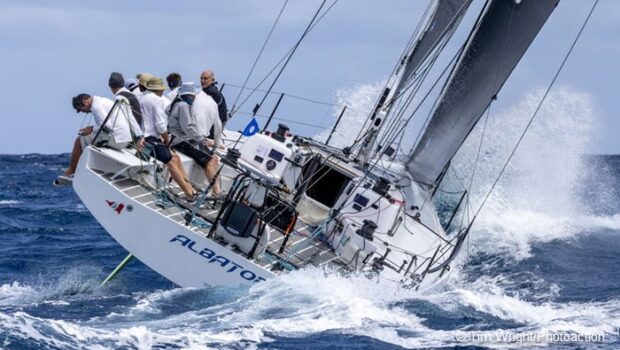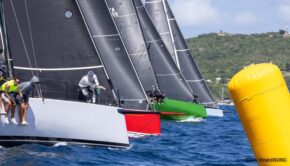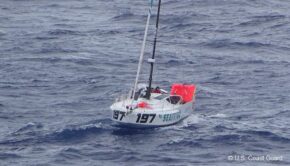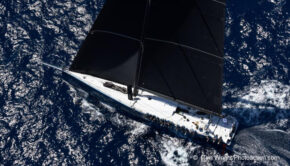Navigators ramping up for Caribbean 600
Published on February 20th, 2025
The 2025 RORC Caribbean 600, which starts from Antigua on February 24, has 66 entrants for the 16th edition across IRC, CSA, Class40, and Multihull divisions. The non-stop 600nm race around 11 islands is a navigator’s dream and nightmare rolled into one.
With a wide fleet of boats racing this year, read the comments on the race by Nikki Henderson skipper of J/122 El Ocaso, Alexis Loison navigator on NM43 Albator and Will Oxley navigator on TP52 Summer Storm:
Unlike traditional offshore races with long, open-water stretches, the RORC Caribbean 600 course creates a constantly shifting tactical challenge. Navigators must plan for a myriad of sail changes and brutal wind and sea transitions shaped by the islands. Nailing the waypoints is crucial to maximize speed and reduce maneuvers.
“The RORC Caribbean 600 is the quintessential race of wind side-effects,” commented Alexis Loison, navigator on Philippe Frantz’s NM43 Albator.“It’s essential to thoroughly analyse the topographical details of each island before the start, to understand how the wind shadow will behave. Hour of the day is also a clue; I have found that the wind shadows are not the same between day and night.”
Nikki Henderson, skipper for the charter guests on J/122 El Ocaso, has done the race three times before, coming second in class in 2020. Her El Ocaso crew are nearly all amateur sailors, but between them they have raced the ‘600 12 times.
“We haven’t looked closely enough at the forecast yet, but probably sometime around 4 days will be our elapsed time,” reports Henderson. “What’s going to affect that? – making it through Guadeloupe, of course, like everyone. Keeping pace on in the upwind legs, which are definitely our strong suit in our class. We need to hope that we can hold our ground on the reaches and will be shooting for the shortest distance on the course wherever possible,” continued Henderson.
The islands create significant wind shadows and acceleration zones, forcing navigators to make critical routing choices. Guadeloupe in particular is famous for its foreboding wind hole, so do you risk playing it safe offshore or do you go right into the ‘Guadeloupe Casino’?
“Last year, at sundown, the boats that made good gains went offshore at Guadeloupe,” recalled Loison. “But at night, it was the boats inshore that made the best route.”
Guadeloupe is not the only wind shadow on the course. Henderson highlighted Saba Island for good reason; El Ocaso will have the advantage of seeing the weather effects of boats in front of them.
“Rounding Saba is always an interesting choice – to play the corner and the curve of the wind round the north tip of the island and hugging the coast before heading up to St Barth’s can often be advantageous,” she offered. “But the wind can also be light down there. We will be keeping an eye on how the boats ahead fare.”
The Caribbean trade winds can be steady, but squalls bring intense bursts of wind and rain. The navigator’s dilemma is to decide whether to avoid them or use them, and sometimes, there is no choice.
Also, Sargassum Weed floating in clumps have been prevalent in the Caribbean for many years, and while it has has both positive and negative effects on the ecosystem, it can be a nightmare for competitors.
“Sargassum has created headaches for crews as it wraps itself around the foils, often necessitating a time consuming backdown,” said Will Oxley, navigator on the TP52 Summer Storm. “The latest thinking is that there is now a source population in the Atlantic that seasonally goes into bloom. It is believed that increased nutrient runoff flowing out from the Amazon and the Congo Rivers plays a role in these blooms.”
Loison considers how managing trade wind squalls is crucial in this type of race. “First, it is essential to anticipate their arrival and adjust your course to benefit from the best angle and wind strength. You need to anticipate and not just react. Significant gains can be achieved. Another important aspect is to anticipate the adjustments and choice of sails to avoid damaging equipment.”
Henderson adds, “We will be monitoring their tracks and aim to stay the best side of them to take advantage of any useful shift if we can’t avoid them. Preparing for them is just about being able to change sails quickly – it’s a long race and making the least mistakes is more important than cutting a squall super fine. Without a moon this year, seeing the squalls at night will be more difficult. We are making sure we get in a full night sail this week in preparation. After all… 50% of the race is in the dark.”
Wil Oxley has competed in three previous editions of the ‘600 with the JuanK 88 Lucky, Volvo 70 Wizard, and VPLP 100 Comanche. He says his focus is to look for convergent clouds.
“Clouds provide a good indication of wind direction. Winds wrap around both sides of the islands and come together on the leeward side. Moist air rises, causing a convergence cloud. People often talk about sucking or blowing clouds.
“A sucking cloud refers to strongly rising air currents. Indicators are rapid vertical development with the cloud visibly growing. Darker cloud bases with crisp edges can indicate lots of moisture being drawn into the cloud.
“Blowing clouds produce strong descending air currents. These blowing clouds can be identified by diffuse or ragged bases, the presence of virga (rain that has not reached the surface), and in more extreme cases a cumulonimbus cloud with a large anvil top. Sounds simple, but sometimes clouds are both sucking and blowing at the same time. Often you learn from the first cloud what is going on.”
The RORC Caribbean 600 is a race of damage control, quick thinking, and adapting on the fly. Success often comes down to minimizing errors and reacting faster than the competition. Sometimes the right call is simply down to trusting instincts.
“The RORC Caribbean 600 can never be perfect,” admitted Henderson. “I’d say, a race where there is almost an indefinite room for improvement is like an addictive drug… you keep wanting to come back for more.”
Event information – Race details – Entry list – Tracker
THE RORC CARIBBEAN 600 SERIES:
• The 16th edition of the RORC Caribbean 600 starts from Antigua on February 24, 2025. The 600nm course circumnavigates 11 Caribbean Islands starting from Fort Charlotte at English Harbour and heads north as far as St Martin and south to Guadeloupe taking in Barbuda, Nevis, St Kitts, Saba and St Barth’s
• Before the epic 600-mile offshore challenge of the RORC Caribbean 600, sailors will set their sights on the third edition of the RORC Nelson’s Cup Series, which is now a stand-alone event with its own prizegiving. Combining inshore races with the exhilarating 360° Round Antigua Race, the Nelson’s Cup Series promises intense action on the water, camaraderie ashore and is open to boats that are not competing in the RORC Caribbean 600.
RORC Caribbean 600 Records
• Multihull Record: 01 days 05 hrs 48 mins 45 secs in 2022 by MOD70 Argo (Jason Carroll)
• Monohull Record: 01 days 13 hrs 41 mins 45 secs in 2018 by Rambler 88 (George David)
• IRC Corrected Record: 03 days 10 hrs 09 mins 41 secs in 2022 by Pac52 Warrior Won (Christopher Sheehan)
RORC CARIBBEAN 600 – PAST IRC OVERALL WINNERS:
2024 – Joost Schuijff, Farr100, Leopard 3 (MON)
2023 – Roy P. Disney, Volvo 70, Pyewacket (USA)
2022 – Christopher Sheehan, Warrior Won, Pac52 (USA)
2020 – Tilmar Hansen, Outsider, TP52 (GER)
2019 – David and Peter Askew, Wizard, Volvo 70 (USA)
2018 – George David, Rambler 88, Maxi (USA)
2017 – Hap Fauth, Bella Mente, JV72 (USA)
2016 – George Sakellaris, Maxi 72, Proteus (USA)
2015 – Hap Fauth, JV72, Bella Mente (USA)
2014 – George Sakellaris, RP72, Shockwave (USA)
2013 – Ron O’Hanley, Privateer, Cookson 50 (USA)
2012 – Niklas Zennström’s JV72, Rán (GBR)
2011 – George David, Rambler 100, JK 100 (USA)
2010 – Karl C L Kwok, Beau Geste, Farr 80 (HKG)
2009 – Adrian Lee, Lee Overlay Partners, Cookson 50 (IRL)
Source: Royal Ocean Racing Club










 We’ll keep your information safe.
We’ll keep your information safe.